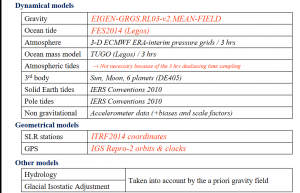General
The times series of GRACE+SLR CNES/GRGS RL04 solutions is provided in spherical harmonic coefficients up to degree and order 90.
Data
The version of the Grace data used for RL04 is L1B-v2.
The data from the Star Camera Assembly (SCA), Accelerometer (ACC), K-Band Ranging (KBR) and GPS receiver are used. The KBR data is processed in the form of the relative velocity between the spacecrafts: K-Band Range-Rate (KBRR).
In addition to the data from GRACE, the data from 5 SLR satellites are also used (Lageos, Lageos-2, Starlette, Stella and Ajisai), in order to provide an accurate and consistent description of the very low degrees of the gravity field (mainly degrees 1 and 2). As a consequence, there is a solution for degree 1 in the CNES/GRGS time series (coming from the SLR data) and there is no need to substitute the degree 2 coefficients by another set coming from an external source. The determination of degree 2 from the combination of the SLR and GRACE data is self-consistent with the rest of the other coefficients of the solution.
GRACE data:
KBR L1B-v2 data
Standard arc duration: 1 day
KBRR weighting:
- 2003-2012 = 0.2 μm/s + cos(φ) downweighting
- 2002 & 2013-2017 = 0.1 μm/s + cos(φ) downweighting
GPS data:
- data sampling: 30ʺ
- data weighting: σcode = 100 cm, σphase = 2 cm
Parameters:
- Accelerometer biases: 1/half-revolution, piece-wise linear, on each axis
- Accelerometer scale factors: 1/day, constant, on each axis
- KBRR measurements: 1 bias + 1 slope per half-revolution, piece-wise linear
- KBR phase centers: 1/day Y & Z coordinates, for each sat
SLR data:
- Lageos1/2 data (10-day arcs, σapriori = 6 mm)
- Starlette/Stella data (5-day arcs, σapriori = 10 mm)
Gravity parameters:
- Gravity spherical harmonic coefficients complete to degree and order 90 (truncated to 30 for LAGEOS and 40 for GPS data)
- Ocean tides s. h. coefficients for 14 tidal waves with maximum degree/order ≤ 30 (not yet available)
A priori models

Inversion method
By contrast with the GRACE solutions in spherical harmonics provided by other groups, the CNES/GRGS solutions are not obtained by a simple Cholesky inversion. The normal matrices are first diagonalized, ordered by decreasing order of the eigen values and only the best defined sets of linear combinations of the spherical harmonics are solved.
Since the gravity field is complete to degree and order 90, there are 91×91 = 8281 spherical harmonics coefficients and therefore 8281 linear combinations of spherical harmonics once the diagonalization is performed. On these 8281 linear combinations, 1500 are always solved without any constraint, approximately 2500 are solved with a progressive constraint towards their a priori value and the rest is left unsolved, i.e. is kept to its a priori value.
Citation
To cite CNES/GRGS RL04 products, please use DOI: https://doi.org/10.5880/ICGEM.2019.010